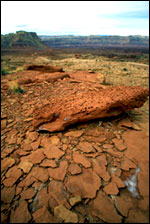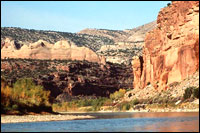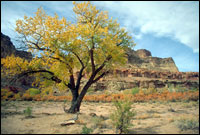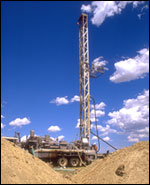
Your red rocks, in Utah.
Photo: BLM.
The old Woody Guthrie ballad “This Land Is Your Land” has been reinterpreted in more ways than one recently. There was the hilarious campaign parody cartoon that exploded virally throughout the Internet last month, in which the “liberal wiener” (John Kerry) and “right-wing nut job” (George W. Bush) duke it out to an adulterated “This Land” soundtrack.
Then, this week at the Department of Interior, there was a far subtler reinterpretation of the Guthrie anthem — a reminder that while there are some 261 million acres of public land in America (not counting parks and wildlife refuges), which technically belong to “you and me,” those who control them are not always motivated by Guthrie’s populist ideals.
The Bureau of Land Management has long had the authority to lease this land to industry for resource extraction and sell select parcels if such sales “serve the national interest.” But soon, at the behest of the Bush administration, the agency may be given added incentive to sell lands — and then be permitted to use the proceeds for projects that critics argue won’t necessarily benefit the American people.
On Monday, Lynn Scarlett, an assistant secretary at the Department of Interior, which encompasses the BLM, sent a letter [PDF] to House Speaker Dennis Hastert (R-Ill.) urging Congress to adopt legislation that would change the way the government can use the money generated by selling BLM land.
Historically, Congress has required the DOI to put all earnings from federal land sales directly into the U.S. Treasury — which Scarlett says discouraged the BLM from selling off public lands for such worthwhile uses as urban and community development.

Lynn Scarlett.
Photo: DOI.
“There has long been a concern that BLM really didn’t have any incentive to sell [portions of its holdings] that are unmanageable and not germane to its mission,” Scarlett told Muckraker. “There’s a lot of work involved in doing the surveys and appraisals and so forth that are necessary to sell land, and as long as the revenues from the sale go straight off to the Treasury, it’s all cost to BLM and not necessarily much benefit.” The point of this new proposal, she said, “is to provide sufficient motivation for the BLM to be able to sell the land parcels that are designated as suitable for sale.”
Environmentalists bristle at such logic. “Why on earth should there be an incentive?” asked Johanna Wald, director of the lands program at Natural Resources Defense Council. “All decisions to sell land owned by the public should be made without external incentives or pressures driving them in one direction or another. That process should be completely neutral.”
Wald and other environmentalists acknowledge that a number of parcels of BLM land scattered within or near towns, cities, and ranches don’t harbor substantial natural resources of national interest — say, wildlife or energy resources — and therefore would be reasonable to sell off to private interests.
In 2000, President Clinton signed into law a measure sponsored by Sen. Pete Domenici (R-N.M.) that allowed the BLM to hold on to any proceeds it made from the sale of the more than 3 million acres of public land that had already been earmarked for sale, much of it with little ecological value. A maximum of 20 percent of the profits could go to the agency to help cover administrative expenses for land sales, and a minimum of 80 percent had to be used to buy inholdings (privately owned tracts inside wilderness areas, national monuments, or other federally designated lands).

Your canyons, in Colorado.
Photo: BLM.
“The initial program wasn’t very controversial,” said David Alberswerth, director of the Wilderness Society‘s BLM program. “The idea was to free up the BLM to sell some of these isolated parcels that had already been identified for sale and use the proceeds to buy inholdings and tracts adjacent to existing BLM lands that are more ecologically sensitive.”
But to determine whether the system would work as well in practice as in principle, a 10-year sunset clause was built into the program so analysts could have a chance to assess it — how much new land the bureau would buy, how much it would sell, and what agency officials would do with the proceeds on an administrative level.
“The BLM was supposed to put out annual reports on the program, but we haven’t seen any,” said Alberswerth. “And now the Bush administration is proposing to extend the program another five years and give it much broader authority, opening up the program to land sales in new, potentially sensitive areas.”
Indeed, as Scarlett writes to Hastert, “The BLM is currently undergoing a major effort in land use plan revisions and updates” and is identifying new lands to be sold. The Salt Lake Tribune reports that the administration’s proposal could result in up to 10 million acres being put on the auction block.
The proposal also adds a critical new incentive to the 2000 statute: Only 60 percent of land-sales profits would have to be spent on acquiring new land parcels. Twenty percent would continue to go toward administrative expenses, and the remaining 20 percent could go to fund projects that would “enhance the conservation of federal lands.”
Critics wonder exactly what such projects would entail. “There’s no telling what they mean by ‘conservation-enhancing projects,'” said Wald. “Do they mean projects of the ‘Healthy Forest’ variety, for instance, that would strip old-growth trees from public lands in the name of conservation? Or grazing projects that would allow ranchers free range over public lands?”
Scarlett insists that the money would be channeled to eco-sensitive causes. “The funds will go to local BLM managers for modest projects, like seeding lands with native grasses,” she told Muckraker, “or removing invasive weeds, or reducing erosion along a stream bank, or grooming trails.”
The funds “would be very, very modest compared to the overall BLM budget,” Scarlett said, “they will just add a little extra oomph.” She said the revenues generated from the 2000 act have been “in the handfuls of millions,” which is negligible compared to the agency’s average annual budget of roughly $1.9 billion. Environmentalists, though, fear that the program won’t be small for long. “I guarantee you that if this legislation is passed and Bush comes into office for a second term, instructions will go out to the field to step up efforts to identify disposable parcels,” said Alberswerth.
Also, Alberswerth said he’s heard from people inside the DOI that the 2006 budget proposed by the Bush administration includes a 2.3 percent cut to the government’s land-management programs. “You can see what’s going on here: The Bush administration is readying big budget cuts in conservation and environmental programs, and the Interior Department is trying to figure out how it can finance conservation and acquisition programs from public land sale proceeds,” he said.

Your tree, in Utah.
Photo: BLM.
Enviros also note that the proposal was submitted at the 11th hour of the 108th Congress — before a potential shakeup brought about by the November election. “I think the plan was to try and sneak it through below the radar screen, maybe have it added to another piece of legislation, and get it enacted before anyone realized it was controversial,” said Wald.
Scarlett insists, however, that there is nothing controversial about the proposal. “The notion that somehow vast swaths of additional land could somehow come on the auction block fails to take into account the disciplined decision process behind identifying land that is identified for potential sale,” she said. “There are stringent limitations and restrictions on what kind of parcels can be sold. It’s a very public, very transparent process with a NEPA [National Environmental Policy Act] review and comment period and very clear rules of engagement.”

Not your drill, in Wyoming.
Photo: BLM.
Indeed, the process governing BLM land sales is no stricter than the process for selling oil and gas leases on public land. “Take a look at the extraordinary increase in sales of leases in spectacular and sensitive regions like Utah’s red rock canyon country,” said Wald. “That shows you how strict and rigorous the existing approval process is. By no means will it prevent them from selling off our national treasures.”
Over the past few months, in fact, the BLM has issued land-use plans to open an additional 5.4 million acres of federal land in Montana, New Mexico, Utah, and Wyoming to possible oil and gas drilling, even though the bureau itself has acknowledged that portions of these lands fit the legal description of wilderness established by Congress.
Right now, the question of what land really does belong to you and me feels uncomfortably ambiguous.


